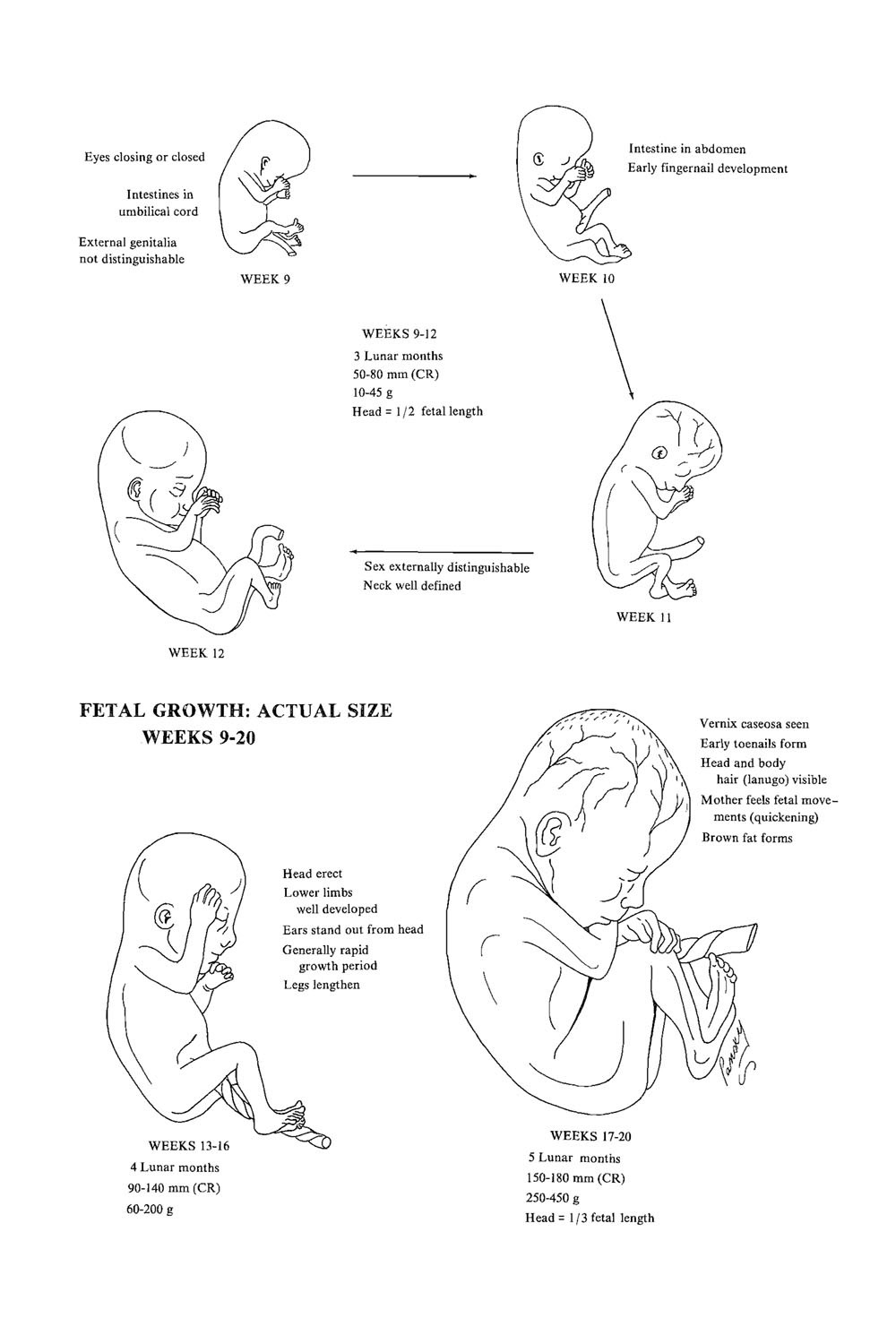28. The Fetal Period: Weeks 9 to 20 of Development
Review of MEDICAL EMBRYOLOGY Book by BEN PANSKY, Ph.D, M.D.
- Introduction: development from embryo to fetus is not abrupt, but the embryo changes to a recognizable human being and develops all the basic outlines of its organs and is then called a fetus. This long (7-month) fetal period is concerned with growth and differentiation of tissues and organs that began to develop in the embryonic period, maturation of the primordia, reorganization of spatial relationships of primordia, and the embryo begins to make functional use of its organs for part of its needs. Its volume and weight increase proportionally, and it grows considerably, from about 30 mm (CR) to about 330 mm (CR). Fetal growth is complex and is really a phenomenon which results from the sum of very asynchronous growth of different organs and parts even at the histologic level (histogenesis). Body proportions at term are very different from the fetus of 2 or 3 months
- Fetal age is best expressed in weeks. Most uncertainty comes from the use of both calendar months (28-31 days) or lunar months (28 days). Most use calendar months
- GESTATIONAL PERIOD is divided into 3 trimesters or parts of 3 calendar months each
- By the end of the first trimester, all major systems are developed, and CR length is about as wide as one's palm
- At the end of the second trimester (26 weeks according to LMP but only 24 weeks related to time of fertilization), the fetus is too immature to live independently and is about the size of a handspan
- Fetal period changes
- WEEKS 9 TO 12 (STAGE OF INITIAL FETAL ACTIVITY)
- Beginning of week 9: the head is about half the fetal size, but growth of the body in CR length more than doubles by the end of week 12
- One sees a broad face, eyes widely separated, ears low set, and eyelids fused so that the conjunctival sacs are closed
- Beginning of week 9, the legs are short and thighs relatively small, but by the end of week 12, the upper limbs reach relatively normal lengths, even though the lower limbs are not well developed and are relatively shorter than normal
- The external genitalia of male and female appear similar until end of week 9
- Intestinal loops are clearly seen in the proximal end of the umbilical cord until the middle of week 10 when they return to the abdomen
- By the end of week 12, the fetus will react to stimuli (seen in aborted fetuses)
- WEEKS 13 TO 16 (PERIOD OF RAPID FETAL GROWTH)
- By end of week 16, the head is relatively small compared to a 12-week fetus
- Legs have become longer
- Skeletal ossification progresses rapidly and is seen on x-ray by week 16
- Scalp hair pattern gives some clue to early brain development
- WEEKS 17 TO 20
- Growth slows, but fetal CR length increases by 50 mm and lower limbs reach their final relative proportions
- Fetal movements (quickening) are generally felt by mother
- Skin is covered by the vernix caseosa (greasy, cheeselike material) by week 20 due to fetal sebaceous gland secretion and dead epithelial cells
- Protects fetal skin from chapping, abrasions, and hardening due to amniotic fluid around it
- By week 20, the fetus is covered by lanugo, a fine downy hair
- The eyebrows and head hair are visible
- Brown fat forms and is the site of heat production (in the newborn)
- Brown fat is specialized adipose tissue that produces heat by oxidizing fatty acids and is chiefly found in the floor of the anterior triangle of the neck surrounded by the subclavian and carotid vessels, behind the sternum, and in the perirenal areas



